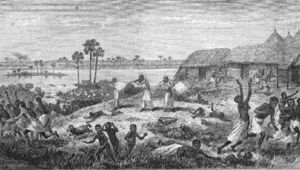- Nyangwe
-
Nyangwe was a town in Maniema, on the right bank of the Lualaba in the Democratic Republic of Congo (territory of Kasongo). It was one of the main slave trading states in the region at the end of the 19th century.
The town was founded around 1860, and a first sultan named Dougombi established in 1868. Munia Muhara was the sultan of the town by the time of the 1892-1894 war in the Eastern Congo.
David Livingstone was the first European to visit the town in 1871. On July 15, 1871 Livingstone witnessed approximately 600 Africans massacred by Arab slavers.[1] It was the last known town for people coming from the East, and Livingstone thought that the Lualaba was the high part of the Nile River. Verney Lovett Cameron visited the town in 1874. Both Livingstone and Cameron failed to follow the river downstream due to fiendish inhabitants, thereby missing a proof (or disprove, as it would turn out) of the statement that it was feeding the Nile. In 1877 Henry Morton Stanley followed the river downstream from Nyangwe with local reigning Tippu Tip, and as he arrived in Boma, he established that this was the Congo River. Hermann von Wissmann visited Nyangwe in 1883.
Notes
- ^ Livingstone by Tim Jeal (New Haven, Yale University Press,1973, p. 331-335.)
Coordinates: 4°13′S 26°11′E / 4.217°S 26.183°E
Categories:- Populated places established in 1860
- Populated places in Maniema Province
- Lualaba River
- Democratic Republic of the Congo geography stubs
Wikimedia Foundation. 2010.

